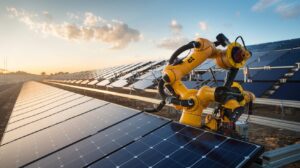American Battery Technology secures $900 million loan to power the future of U.S. clean energy, placing the U.S. on a new path toward domestic lithium independence and technological leadership in the global clean energy race.
How This $900 Million Loan Strengthens U.S. Clean Energy Goals
The $900 million Letter of Interest granted by the U.S. Export-Import Bank (EXIM) will fund American Battery Technology Company’s Tonopah Flats Lithium Project in Nevada. This financial backing will help establish one of the nation’s first large-scale lithium extraction and refining facilities, critical for reducing reliance on foreign nations—particularly China—for lithium.
This loan directly supports two strategic federal programs:
- Make More in America: Encourages U.S. domestic manufacturing of high-demand products like batteries.
- China and Transformational Export Program: Aims to counter foreign influence in strategic industries like clean tech.
Breaking Down the Tonopah Flats Lithium Project
What Is It?
A first-of-its-kind facility where lithium will be extracted from claystone and refined into lithium hydroxide using ABTC’s proprietary low-impact process.
Why Is It Important?
It gives the U.S. a homegrown supply of lithium, needed for EV batteries, grid storage, and mobile technology—where the country currently imports over 50%.
Key Benefits of the Project for America
| Category | Impact |
|---|---|
| U.S. Lithium Output | +30,000 metric tons annually |
| EV Support | Can supply batteries for 750,000+ electric vehicles per year |
| Job Creation | Hundreds of direct jobs, thousands of indirect ones |
| Energy Independence | Reduces overreliance on China, Chile, and Argentina |
| Environmental Impact | Closed-loop extraction process reduces emissions and waste |
This facility may help the U.S. catch up with global players in lithium production while keeping the benefits within the American economy.
Why American Battery Technology’s Refining Technology Is a Game-Changer
American Battery Technology Company’s proprietary claystone-to-lithium refining method is what truly separates this project from previous ones. Unlike traditional brine or hard rock methods that use massive amounts of water or chemicals, this method is:
- Faster: Extracts and refines on-site, cutting turnaround times.
- Cleaner: Uses lower emissions, closed-loop processing.
- Cheaper: Reduces total cost per ton, improving scalability.
These innovations increase investor and government confidence in long-term sustainability.
Strategic Importance for the U.S. Economy and Security
This project isn’t just about clean energy—it’s about economic leadership and national resilience.
If successful, ABTC’s site will:
- Strengthen U.S. control over strategic minerals
- Position the U.S. as a net exporter of refined lithium
- Support federal goals under the Biden Administration’s clean energy policies
U.S. Geological Survey data reveals that in 2023, global lithium demand exceeded 134,000 metric tons, and the U.S. produced under 3% of it. This project could significantly move that needle.
How This Impacts the U.S. EV and Clean Tech Market
Without reliable lithium, U.S. automakers like Ford, GM, and Tesla can’t scale EV production affordably. Currently, they face:
- Material shortages
- Rising costs from global suppliers
- Delays in production pipelines
With ABTC’s lithium production in Nevada, automakers can:
- Cut costs
- Reduce wait times
- Ensure stable supply chains
That’s why this project is so closely tied to the U.S. Department of Energy’s Battery Blueprint.
The Global Race for Lithium: Can the U.S. Catch Up?
Here’s how the U.S. compares to global lithium leaders:
| Country | 2024 Production (Est.) | Refining Dominance | U.S. Position |
|---|---|---|---|
| China | ~20,000+ tons | Controls 60% of refining | Dominant in lithium processing |
| Australia | ~18,000+ tons | Low refining capacity | Exports raw materials |
| Chile | ~15,000+ tons | Refining in China mostly | Relies on foreign partnerships |
| USA (Now) | ~3,000 tons | Minimal refining | Imports majority |
| USA (Post-ABTC) | 30,000 tons (projected) | Domestic refining built-in | Closing the global gap fast |
This shows the Tonopah Flats project isn’t just big for the U.S.—it’s essential for competing globally.
What the Future Looks Like After This $900M Investment
Once completed, the Tonopah Flats facility will:
- Support hundreds of U.S. manufacturing and tech companies
- Be a blueprint for future domestic battery supply chain facilities
- Lower EV prices for U.S. consumers through material availability
- Serve as a case study in clean-tech success from government-industry cooperation
Impact Flow of ABTC’s $900M Loan
$900M EXIM Loan
|
-----------------------------
| |
Tonopah Flats Project Economic Impact
| |
---------------------- -----------------------
| | | | | |
Lithium Refining Jobs Created Clean Tech Growth EV Market Expansion
This visual shows how one investment has wide-reaching effects on jobs, national policy, technology, and consumer benefits.
Trusted Government Backing: A Long-Term Vote of Confidence
The U.S. Export-Import Bank’s involvement signals trust in both the economic and environmental sustainability of ABTC’s project.
Conclusion: American Battery Technology Is Leading the U.S. Energy Future
American Battery Technology securing a $900 million loan to power the future of U.S. clean energy is a landmark moment. It represents more than financing — it’s a bold step toward true energy independence, national economic growth, and clean technology leadership.
With lithium demand expected to surge more than 40x by 2040, projects like Tonopah Flats are essential. As the U.S. builds toward a future of electric mobility, battery storage, and sustainable industry, ABTC is now at the forefront.
This is the kind of transformation that ensures America leads—not follows—the next global energy era.
[USnewsSphere.com / mt.]





